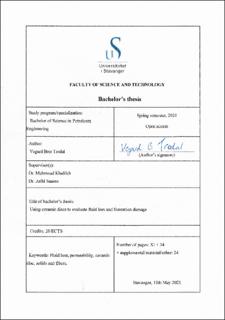| dc.contributor.advisor | Khalifeh, Mahmoud | |
| dc.contributor.advisor | Saasen, Arild | |
| dc.contributor.author | Trodal, Vegard | |
| dc.date.accessioned | 2021-09-07T16:31:08Z | |
| dc.date.available | 2021-09-07T16:31:08Z | |
| dc.date.issued | 2021 | |
| dc.identifier | no.uis:inspera:78834598:36987758 | |
| dc.identifier.uri | https://hdl.handle.net/11250/2774448 | |
| dc.description.abstract | To prevent kicks and possible blowout of the well, the pressure from the drilling fluid must be kept above the pore pressure of the formation. This differential pressure forces the fluid into the porous formation, which results in fluid loss. Occasionally, the pressure can also exceed the formation fracturing pressure, leading to lost circulation. In both cases, fluid migrates into the formation, and may damage it in the process. In this study, the relationship between filtration volume and formation damage has been investigated. The methodology is centered around using porous discs to measure fluid filtrate and changes in permeability and mass of the discs. Fifteen samples of drilling fluid were created with different solid, polymer and fiber content. Filtrate volume was recorded by conducting a HTHP fluid loss test with a differential pressure of 6.9 MPa (1000 psi), at 90 ℃ for 30 minutes. The discs were weighed in dry conditions at the start and end of the test procedure in order to measure mass of the invasion caused by the filtrate. Changes in permeability to both water and air was determined, which combined with invasion mass, serve as indicators of formation damage. The results show how the different additives may improve the sealing capabilities and reduce filtrate volume, but that it does not necessarily correlate with reducing invasion and damage to the formation. | |
| dc.description.abstract | To prevent kicks and possible blowout of the well, the pressure from the drilling fluid must be kept above the pore pressure of the formation. This differential pressure forces the fluid into the porous formation, which results in fluid loss. Occasionally, the pressure can also exceed the formation fracturing pressure, leading to lost circulation. In both cases, fluid migrates into the formation, and may damage it in the process. In this study, the relationship between filtration volume and formation damage has been investigated. The methodology is centered around using porous discs to measure fluid filtrate and changes in permeability and mass of the discs. Fifteen samples of drilling fluid were created with different solid, polymer and fiber content. Filtrate volume was recorded by conducting a HTHP fluid loss test with a differential pressure of 6.9 MPa (1000 psi), at 90 ℃ for 30 minutes. The discs were weighed in dry conditions at the start and end of the test procedure in order to measure mass of the invasion caused by the filtrate. Changes in permeability to both water and air was determined, which combined with invasion mass, serve as indicators of formation damage. The results show how the different additives may improve the sealing capabilities and reduce filtrate volume, but that it does not necessarily correlate with reducing invasion and damage to the formation. | |
| dc.language | eng | |
| dc.publisher | uis | |
| dc.title | Using ceramic discs to evaluate fluid loss and formation damage | |
| dc.type | Bachelor thesis | |
